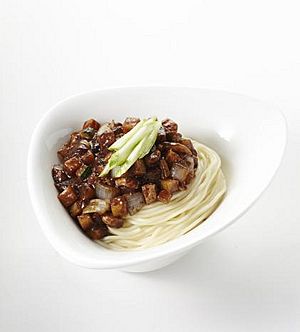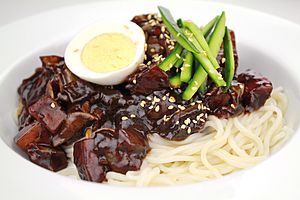Jajangmyeon facts for kids
 |
|
| Alternative names | Jjajangmyeon |
|---|---|
| Type | Myeon |
| Place of origin | South Korea |
| Region or state | East Asia |
| Main ingredients | cumian, chunjang, meat, vegetables, sometimes seafood |
| Similar dishes | Zhajiangmian |
| Korean name | |
| Hangul |
자장면
|
|---|---|
| Hanja |
炸醬麵
|
| Revised Romanization | jajangmyeon |
| McCune–Reischauer | chajangmyŏn |
| IPA | [tɕa.dʑaŋ.mjʌn] |
| Hangul |
짜장면
|
| Hanja |
炸醬麵
|
| Revised Romanization | jjajangmyeon |
| McCune–Reischauer | tchajangmyŏn |
| IPA | [t͈ɕa.dʑaŋ.mjʌn] |
Jajangmyeon (자장면) or jjajangmyeon (짜장면) is a super popular Korean noodle dish. It comes with a thick, yummy sauce made from a special black bean paste called chunjang. This sauce also has diced pork and vegetables. Sometimes, you might find it with seafood or other meats too! It's a favorite meal for many in South Korea.
Contents
History of Jajangmyeon
Jajangmyeon first came to Korea in the late 1800s. Chinese workers from the Shandong province of China brought it with them. They were sent to Korea by the Chinese military.
The dish was first sold in 1905 at a Chinese restaurant called Gonghwachun. This restaurant was in Incheon Chinatown and run by someone from the Shandong region. Today, this old restaurant building is the Jajangmyeon Museum.
The name and the dish itself come from a Chinese noodle dish called zhájiàngmiàn. Both dishes use pork, long wheat noodles, and a sauce made from fermented soybean paste. However, jajangmyeon has a thicker and darker sauce. This is because it uses starch and caramel coloring. One history professor, Yong Chen, said that even though the dish started as Chinese, it is now "thoroughly Korean."
After the Korean War in the mid-1950s, jajangmyeon was sold very cheaply in South Korea. This meant everyone could afford to eat it. It became super popular with merchants and dock workers in Incheon, a busy port city. Soon, it spread all over the country.
The Name Jajangmyeon
The word Jajang (자장) means "fried sauce" in Korean. It comes from the Chinese word zhájiàng. Myeon (면) simply means "noodles."
You might see it spelled jajangmyeon or jjajangmyeon. The Chinese sound zhá sounded more like jja to Korean ears. So, most Korean Chinese restaurants use the spelling jjajangmyeon.
For many years, the official language group in Korea did not accept jjajangmyeon as a standard spelling. But in 2011, they changed their minds! Now, both jajangmyeon and jjajangmyeon are accepted as correct spellings in the official Korean dictionary.
How Jajangmyeon is Made and Served
Jajangmyeon uses thick noodles. These noodles are made from wheat flour, salt, and baking soda. They can be made by hand or by machine.
The special sauce, called jajang, is made by frying chunjang. Other ingredients are added, like soy sauce or oyster sauce. It usually has pork or sometimes beef. You might also find seafood like squid or shrimp.
To make the sauce even tastier, people add scallions, ginger, and garlic. Common vegetables include onions, zucchini or Korean zucchini, and cabbage. A little stock and starch are used to make the sauce thick.
When you get your jajangmyeon, it often has toppings. These can be thin strips of cucumber, more scallions, or a boiled or fried egg. Sometimes, you'll see blanched shrimp or stir-fried bamboo shoot slices.
The dish is usually served with danmuji (yellow pickled radish). You also get sliced raw onions and extra chunjang sauce for dipping the onions.
Different Kinds of Jajangmyeon
There are a few fun variations of jajangmyeon to try:
- Gan-jjajang (간짜장) – This version has a "dry" sauce. It's made without adding water or starch to the sauce. The word gan means "dry" in Chinese.
- Jaengban-jjajang (쟁반짜장) – For this dish, the noodles are stir-fried with the sauce in a large pan called a wok. It's served on a plate instead of in a bowl. Jaengban means "plate" in Korean.
- Yuni-jjajang (유니짜장) – This jajangmyeon is made with ground meat instead of diced meat. The word yuni comes from a Chinese word meaning "ground meat."
- Samseon-jjajang (삼선짜장) – This type of jajangmyeon includes seafood like squid and mussels. The word samseon means "three fresh ingredients" in Chinese.
You can even find combinations, like samseon-gan-jjajang. This would be a seafood jajangmyeon made without adding water to the sauce.
Other dishes also use the jajang sauce. Jajang-bap is the same sauce served over rice instead of noodles. Jajang-tteok-bokki is a dish of chewy rice cakes with jajang sauce, instead of the usual spicy sauce. There's also Bul jajangmyeon, which is a spicy version of the classic dish.
You can also find instant jajangmyeon products, like Chapagetti. These are like instant noodles where you boil the noodles, drain them, and mix them with a jajang powder or liquid sauce.
See also
 In Spanish: Jajangmyeon para niños
In Spanish: Jajangmyeon para niños







